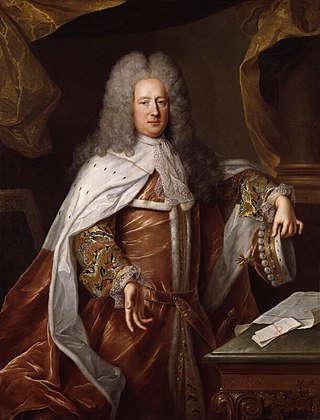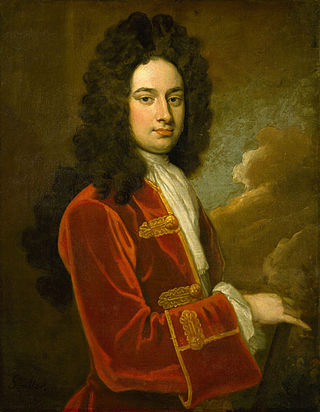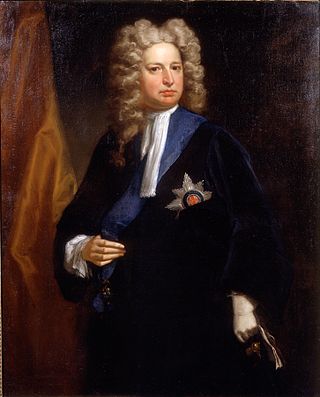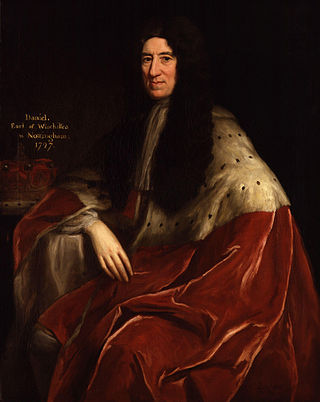The Whigs were a political faction and then a political party in the Parliaments of England, Scotland, Ireland, Great Britain, and the United Kingdom. Between the 1680s and the 1850s, the Whigs contested power with their rivals, the Tories. The Whigs merged into the Liberal Party with the Peelites and Radicals in the 1850s. Many Whigs left the Liberal Party in 1886 to form the Liberal Unionist Party, which merged into the Conservative Party in 1912.

George II was King of Great Britain and Ireland, Duke of Brunswick-Lüneburg (Hanover) and a prince-elector of the Holy Roman Empire from 11 June 1727 (O.S.) until his death in 1760.

George I was King of Great Britain and Ireland from 1 August 1714 and ruler of the Electorate of Hanover within the Holy Roman Empire from 23 January 1698 until his death in 1727. He was the first British monarch of the House of Hanover.

Robert Walpole, 1st Earl of Orford,, known between 1725 and 1742 as Sir Robert Walpole, was a British statesman and Whig politician who, as First Lord of the Treasury, Chancellor of the Exchequer, and Leader of the House of Commons, is generally regarded as the de facto first Prime Minister of Great Britain.

Henry St John, 1st Viscount Bolingbroke was an English politician, government official and political philosopher. He was a leader of the Tories, and supported the Church of England politically despite his antireligious views and opposition to theology. He supported the Jacobite rebellion of 1715 which sought to overthrow the new king George I. Escaping to France he became foreign minister for the Pretender. He was attainted for treason, but reversed course and was allowed to return to England in 1723. According to Ruth Mack, "Bolingbroke is best known for his party politics, including the ideological history he disseminated in The Craftsman (1726–1735) by adopting the formerly Whig theory of the Ancient Constitution and giving it new life as an anti-Walpole Tory principle."

Thomas Pelham-Holles, 1st Duke of Newcastle upon Tyne and 1st Duke of Newcastle-under-Lyme, was an English Whig statesman who served as Prime Minister of Great Britain, his official life extended throughout the Whig supremacy of the 18th century. He is commonly known as the Duke of Newcastle.

James Stanhope, 1st Earl Stanhope was a British Army officer, politician, diplomat and peer who effectively served as Chief Minister between 1717 and 1721. He was also the last Chancellor of the Exchequer to sit in the House of Lords.

Charles Townshend, 2nd Viscount Townshend, was an English Whig statesman. He served for a decade as Secretary of State for the Northern Department from 1714 to 1717 and again from 1721 to 1730. He directed British foreign policy in close collaboration with his brother-in-law, prime minister Robert Walpole. He was often known as Turnip Townshend because of his strong interest in farming turnips and his role in the British Agricultural Revolution.

Spencer Compton, 1st Earl of Wilmington, was a British Whig statesman who served continuously in government from 1715 until his death in 1743. He sat in the English and British House of Commons between 1698 and 1728, and was then raised to the peerage and sat in the House of Lords. He served as the prime minister of Great Britain from 1742 until his death in 1743. He is considered to have been Britain's second prime minister, after Robert Walpole, but worked closely with the Secretary of State, Lord Carteret, in order to secure the support of the various factions making up the government.

Robert Harley, 1st Earl of Oxford and Earl Mortimer, KG PC FRS was an English statesman and peer of the late Stuart and early Georgian periods. He began his career as a Whig, before defecting to a new Tory ministry. He was raised to the peerage of Great Britain as an earl in 1711. Between 1711 and 1714 he served as Lord High Treasurer, effectively Queen Anne's chief minister. He has been called a prime minister, although it is generally accepted that the de facto first minister to be a prime minister was Robert Walpole in 1721.
The Tories were a loosely organised political faction and later a political party, in the Parliaments of England, Scotland, Ireland, Great Britain and the United Kingdom. They first emerged during the 1679 Exclusion Crisis, when they opposed Whig efforts to exclude James, Duke of York from the succession on the grounds of his Catholicism. Despite their fervent opposition to state-sponsored Catholicism, Tories opposed exclusion in the belief inheritance based on birth was the foundation of a stable society.
The Patriot Whigs, later the Patriot Party, were a group within the Whig Party in Great Britain from 1725 to 1803. The group was formed in opposition to the government of Robert Walpole in the House of Commons in 1725, when William Pulteney and seventeen other Whigs joined with the Tory Party in attacks against the ministry. By the mid-1730s, there were over one hundred opposition Whigs in the Commons, many of whom embraced the Patriot label. For many years, they provided a more effective opposition to the Walpole administration than the Tories were.

The Harleyministry was the British government that existed between 1710 and 1714 in the reign of Queen Anne. It was headed by Robert Harley and composed largely of Tories. Harley was a former Whig who had changed sides, bringing down the seemingly powerful Whig Junto and their moderate Tory ally Lord Godolphin. It came during the Rage of Party when divisions between the two factions were at their height, and a "paper war" broke out between their supporters. Amongst those writers supportive of Harley's government were Jonathan Swift, Daniel Defoe, Delarivier Manley, John Arbuthnot and Alexander Pope who clashed with members of the rival Kit-Kat Club.

The Cobhamite faction were an 18th-century British political faction built around Richard Temple, 1st Viscount Cobham and his supporters. Among its members, the group included the future Prime Ministers William Pitt and George Grenville. They had a general Whig philosophy and were at first supporters of Prime Minister Sir Robert Walpole but later became opponents of his administration.
In British politics, a Whig government may refer to the following British governments administered by the Whigs:

The 5th Parliament of Great Britain was summoned by George I of Great Britain on 17 January 1715 and assembled on the 17 March 1715. When it was dissolved on 10 March 1722 it had been the first Parliament to be held under the Septennial Act of 1716.

Hanoverian Tories were Tory supporters of the Hanoverian Succession of 1714. At the time many Tories favoured the exiled Jacobite James Francis Edward Stuart to take the British and Irish thrones, while their arch rivals the Whigs supported the candidacy of George, Elector of Hanover.

The Peerage Bill was a 1719 measure proposed by the British Whig government led by James Stanhope, 1st Earl Stanhope, and Charles Spencer, 3rd Earl of Sunderland, which would have largely halted the creation of new peerages, limiting membership of the House of Lords.

The Impeachment of Robert Harley, Earl of Oxford was a legal process in the Kingdom of Great Britain in 1715 when the former First Minister Robert Harley, Earl of Oxford was impeached and sent to the Tower of London. Harley was accused of a number of crimes including high treason during his time in office, with charges particularly focusing on his role in the 1713 Peace of Utrecht which ended the War of the Spanish Succession.
















